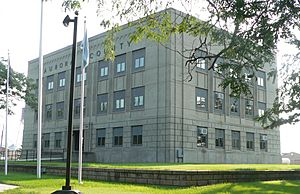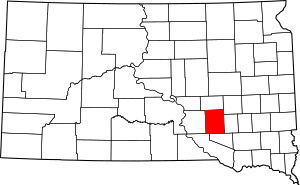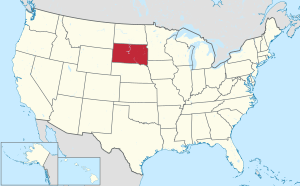Aurora County, South Dakota facts for kids
Quick facts for kids
Aurora County
|
|
|---|---|

Aurora County courthouse in Plankinton
|
|

Location within the U.S. state of South Dakota
|
|
 South Dakota's location within the U.S. |
|
| Country | |
| State | |
| Founded | 1879 (created) 1881 (organized) |
| Named for | Aurora, a Roman goddess |
| Seat | Plankinton |
| Largest city | Plankinton |
| Area | |
| • Total | 713 sq mi (1,850 km2) |
| • Land | 708 sq mi (1,830 km2) |
| • Water | 4.3 sq mi (11 km2) 0.6% |
| Population
(2020)
|
|
| • Total | 2,747 |
| • Estimate
(2023)
|
2,782 |
| • Density | 3.853/sq mi (1.4875/km2) |
| Time zone | UTC−6 (Central) |
| • Summer (DST) | UTC−5 (CDT) |
| Congressional district | At-large |
Aurora County is a county located in the state of South Dakota in the United States. It's a place where people live and work, just like a large town or a small region. In 2020, about 2,747 people lived here. The county was officially started in 1879 and got its organization in 1881.
Contents
The Story of Aurora County
Aurora County got its name from Aurora, who was the Roman goddess of the dawn. Imagine the beautiful colors of sunrise! The Dakota Territory created this county on October 1, 1879. It became officially organized on August 29, 1881. This happened when three special leaders, called county commissioners, were chosen.
Before Aurora County, there were two smaller areas called Cragin and Wetmore. These were formed in 1873. The new Aurora County was made from combining these older areas. The commissioners met and decided that Plankinton would be the main town, also known as the county seat. Voters agreed with this choice in November 1882. Later, on April 17, 1883, the northern part of Aurora County became its own new county, called Jerauld County.
Where is Aurora County?
Aurora County has gentle, rolling hills. Many of these hills are used for farming. You can also find many small lakes and ponds scattered around. The highest part of the county is on its western side. The land then gently slopes down towards the northeast. The lowest point is in the county's northeast corner, which is about 1,325 feet (404 meters) above sea level.
The total size of Aurora County is about 713 square miles (1,847 square kilometers). Most of this area, about 708 square miles (1,834 square kilometers), is land. The rest, about 4.3 square miles (11 square kilometers), is water.
Main Roads and Highways
These are the important roads that go through Aurora County:
Neighboring Counties
Aurora County shares its borders with these other counties:
- Jerauld County - to the north
- Sanborn County - to the northeast
- Davison County - to the east
- Douglas County - to the south
- Charles Mix County - to the southwest
- Brule County - to the west
Special Natural Places
These are areas in Aurora County that are protected for nature and wildlife, often used for hunting or enjoying the outdoors:
- Crystal Lake Public Shooting Area
- Hanson Lake State Public Shooting Area
- Kimball State Public Shooting Area
- Koch Waterfowl Production Area
- Kramer Slaugh Public Shooting Area
- Krell Waterfowl Production Area
- Lutz Waterfowl Production Area
- Maine Waterfowl Production Area
- National Waterfowl Production Area
- Pleasant Lake State Public Shooting Area
- Schute Waterfowl Production Area
- Sorenson Waterfowl Production Area
- Wilmarth Lake Game Production Area
Who Lives Here?
| Historical population | |||
|---|---|---|---|
| Census | Pop. | %± | |
| 1880 | 69 | — | |
| 1890 | 5,045 | 7,211.6% | |
| 1900 | 4,011 | −20.5% | |
| 1910 | 6,143 | 53.2% | |
| 1920 | 7,246 | 18.0% | |
| 1930 | 7,139 | −1.5% | |
| 1940 | 5,387 | −24.5% | |
| 1950 | 5,020 | −6.8% | |
| 1960 | 4,749 | −5.4% | |
| 1970 | 4,183 | −11.9% | |
| 1980 | 3,628 | −13.3% | |
| 1990 | 3,136 | −13.6% | |
| 2000 | 3,058 | −2.5% | |
| 2010 | 2,710 | −11.4% | |
| 2020 | 2,747 | 1.4% | |
| 2023 (est.) | 2,782 | 2.7% | |
| U.S. Decennial Census 1790-1960 1900-1990 1990-2000 2010-2020 |
|||
The population of Aurora County changes over time. Every ten years, the United States counts its population in what is called a census.
In 2020, the census counted 2,747 people living in Aurora County. There were 1,096 households, which are groups of people living together in one home. About 746 of these households were families. The population density was about 3.9 people for every square mile. There were also 1,260 housing units, which are places where people can live.
Looking back at the 2010 census, there were 2,710 people. Most people were white (95.1%). Smaller groups included American Indian (1.5%), Asian (0.7%), and Black or African American (0.4%). Some people were from other races (1.8%) or from two or more races (0.5%). About 3.7% of the people were of Hispanic or Latino background.
Many people in Aurora County have German roots (54.3%). Other common backgrounds include Dutch (13.7%), Norwegian (11.8%), Irish (8.7%), and English (7.2%). The average age of people in the county was about 43.2 years old.
Towns and Cities
Aurora County has several communities where people live.
Cities
- Plankinton (This is the main town, or county seat)
- White Lake
Town
Census-designated places
These are areas that are like towns but are not officially incorporated as cities or towns:
Townships
Townships are smaller local government areas within the county:
- Aurora Township
- Belford Township
- Bristol Township
- Center Township
- Cooper Township
- Crystal Lake Township
- Dudley Township
- Eureka Township
- Firesteel Township
- Gales Township
- Hopper Township
- Lake Township
- Palatine Township
- Patten Township
- Plankinton Township
- Pleasant Lake Township
- Pleasant Valley Township
- Truro Township
- Washington Township
- White Lake Township
See also
 In Spanish: Condado de Aurora para niños
In Spanish: Condado de Aurora para niños

